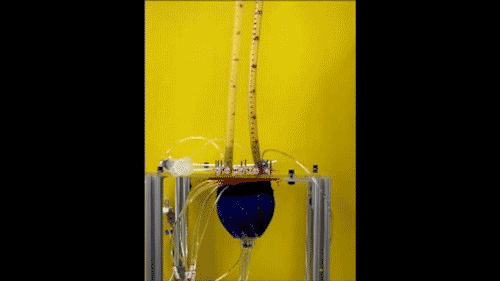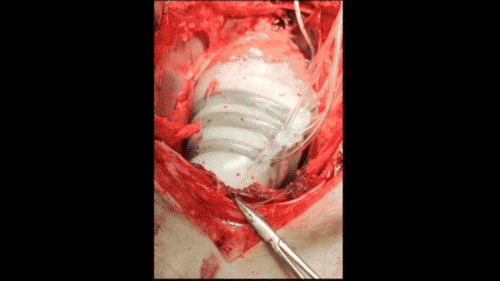The device attaches directly around the heart.
Harvard University and Boston Children’s Hospital researchers have developed a customizable soft robot that fits around a heart and helps it beat, potentially opening new treatment options for people suffering from heart failure.
The soft robotic sleeve twists and compresses in sync with a beating heart, augmenting cardiovascular functions weakened by heart failure. Unlike currently available devices that assist heart function, Harvard’s soft robotic sleeve does not directly contact blood. This reduces the risk of clotting and eliminates the need for a patient to take potentially dangerous blood thinner medications. The device may one day be able to bridge a patient to transplant or to aid in cardiac rehabilitation and recovery.
“This research demonstrates that the growing field of soft robotics can be applied to clinical needs and potentially reduce the burden of heart disease and improve the quality of life for patients,” said Ellen T. Roche, the paper’s first author and former PhD student at the Harvard John A. Paulson School of Engineering and Applied Sciences (SEAS) and The Wyss Institute of Biologically Inspired Engineering at Harvard University. Roche is currently a postdoctoral fellow at the National University of Ireland Galway.
Heart failure affects 41 million people worldwide. Today’s options to treat heart failure include mechanical pumps called ventricular assist devices (VADs), which pump blood from the ventricles into the aorta, and heart transplant. While VADs are continuously improving, patients are still at high risk for blood clots and stroke.
Related Articles
- How Stress May Increase Risk of Heart Disease and Stroke.
- Shoulder pain linked to increased heart disease risk.
- CME: Coronary Heart Disease: Stagnation in Young Adults & Women.
- How to Use Technology to Activate and Engage Patients at Different Points of Care.
Harvard researchers took inspiration from the heart itself to create an entirely new device that doesn’t come into contact with blood. The thin silicone sleeve uses soft pneumatic actuators placed around the heart to mimic the outer muscle layers of the mammalian heart. The actuators twist and compress the sleeve in a similar motion to the beating heart.
The device is tethered to an external pump, which uses air to power the soft actuators.
The sleeve can be customized for each patient, said Roche. If a patient has more weakness on the left side of the heart, for example, the actuators can be tuned to give more assistance on that side. The pressure of the actuators can also increase or decrease over time, as the patient’s condition evolves.
The following graphic is: in vivo demonstration of cardiac assist in a porcine model of acute heart failure.




